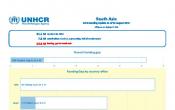India
Operation: India
Location
{"longitude":83,"latitude":22,"zoom_level":5}
Latest update of camps and office locations 13 Jan 2016. By clicking on the icons on the map, additional information is displayed.
Key Figures
| 2015 end-year results | |
| 42% | of Rohingya women were represented in community leadership structures |
| 86% | of unaccompanied and separated children in Delhi benefited from best interest procedures |
| 498 | participants, including local shopkeepers, landlords, doctors, schools, youth and neighborhood associations, benefited from campaigns to enhance peaceful co-existence with host communities |
| 90% | of known SGBV survivors received support |
Latest Updates
People of Concern
1%
Increase in
2015
2015
| 2015 | 207,861 |
| 2014 | 205,012 |
| 2013 | 192,070 |

[["Refugees",201381],["Asylum-seekers",6480]]
Loading ...
Budgets and Expenditure for India
< Back
2015
{"categories":[2012,2013,2014,2015,2016],"budget":[13.21141117,13.00711233,13.6245752,14.714199194,15.0618463],"expenditure":[6.52996445,6.37884488,6.5466772,6.1390603,null]}
{"categories":[2012,2013,2014,2015,2016],"p1":[13.13013324,12.92828938,13.5945752,14.612301274,14.98733329],"p2":[0.08127793,0.07882295,0.03,0.10189792,0.07451301],"p3":[null,null,null,null,null],"p4":[null,null,null,null,null]}
{"categories":[2012,2013,2014,2015,2016],"p1":[6.45845478,6.30452047,6.52077953,6.05843666,null],"p2":[0.07150967,0.07432441,0.02589767,0.08062364,null],"p3":[null,null,null,null,null],"p4":[null,null,null,null,null]}
Loading ...
CHOOSE A YEAR
- 2015
- 2016
Working environment
- The protection environment in India remained positive. 4,200 refugees had their stay regularized, following the issuance of long-term visas which provide access to employment opportunities. In 2015, refugees and asylum-seekers continued to enjoy access to Government services, including health and education.
- The detention of people of concern to UNHCR – mostly of Rohingya asylum-seekers in border areas – continued to be reported. UNHCR scaled up awareness-raising activities on refugee protection, including with border officials. Direct access to people in detention remained a challenge, with some outreach provided through partners.
Population trends
- In 2015, the Government of India effectively protected and assisted over 174,000 Tibetans and Sri Lankans. In addition, India hosted over 33,500 refugees and asylum-seekers registered with UNHCR from other countries.
- Of the 27,000 refugees and 6,500 asylum-seekers registered in 2015, the vast majority were from Myanmar and Afghanistan, with smaller numbers from the Middle East and Africa.
- The number of new arrivals reached 6,500, representing a 17 per cent increase compared to 2014. Afghans constituted the largest group of new arrivals (3,230). Voluntary repatriation of Afghans meanwhile declined from 162 in 2014 to 60 in 2015.
- Voluntary repatriation of Sri Lankan refugees increased from 396 to 452 compared to 2014.
Achievements and impact
- Closer technical cooperation and continued advocacy with the Government of India resulted in simplified long-term visa application procedures.
- Innovative market linkages were established to expand livelihood opportunities for refugees through a new partner. As a result, the livelihoods needs of unskilled Rohingyas in Delhi were partly addressed.
- For the first time, water and sanitation interventions were implemented in Jammu. A pilot livelihood project was also initiated.
- Registration services were introduced in Jammu, as well as registration and mobile refugee status determination (RSD) procedures in Hyderabad, in order to reach out to vulnerable asylum-seekers who could not afford to travel to Delhi.
- The collaboration with legal networks to prevent and respond to detention was strengthened. Trainings with border security officials were held for the first time in 2015.
Unmet needs
- Access to Rohingyas settled outside of Delhi was limited, as UNHCR did not previously have an operational presence in border areas.
- Due to an unexpected increase in Afghan arrivals, RSD targets could not be met.
- Reliable access to public health care, birth certificates, education and SGBV prevention services remained limited outside Delhi.
- Ferry services between India and Sri Lanka did not resume in 2015. As a result, returnee families could not carry all their belongings home, which affected their decisions to return.


